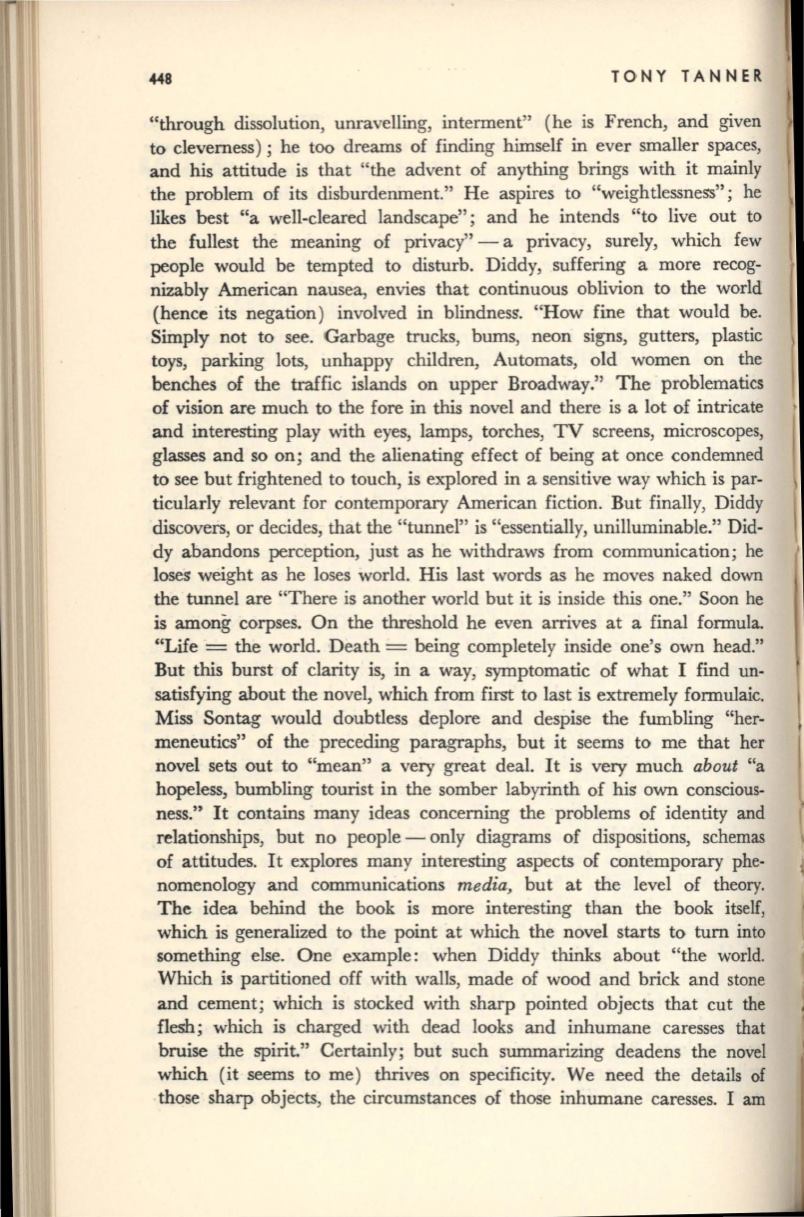
448
TONY TANNER
"through dissolution, unravelling, interment" (he is French, and given
to cleverness); he too dreams of finding himself in ever smaller spaces,
and his attitude is that "the advent of anything brings with it mainly
the problem of its disburdenment." He aspires to "weightlessness"; he
likes best "a well-cleared landscape"; and he intends "to live out to
the fullest the meaning of privacy" - a privacy, surely, which few
people would be tempted to disturb. Diddy, suffering a more recog–
nizably American nausea, envies that continuous oblivion to the world
(hence its negation) involved in blindness. "How fine that would be.
Simply not to see. Garbage trucks, bums, neon signs, gutters, plastic
toys, parking lots, unhappy children, Automats, old women on the
benches of the traffic islands on upper Broadway." The problematics
of vision are much to the fore in this novel and there is a lot of intricate
and interesting play with eyes, lamps, torches, TV screens, microscopes,
glasses and so on; and the alienating effect of being at once condemned
to see but frightened to touch, is explored in a sensitive way which is par–
ticularly relevant for contemporary American fiction. But finally, Diddy
discovers, or decides, that the "tunnel" is "essentially, unilluminable." Did–
dy abandons perception, just as he withdraws from communication; he
loses weight as he loses world. His last words as he moves naked down
the tunnel are "There is another world but it is inside this one." Soon he
is among corpses. On the threshold he even arrives at a final formula.
"Life
=
the world. Death
=
being completely inside one's own head."
But this burst of clarity is, in a way, symptomatic of what I find un–
satisfying about the novel, which from first to last is extremely formulaic.
Miss Sontag would doubtless deplore and despise the fumbling "her–
meneutics" of the preceding paragraphs, but it seems to me that her
novel sets out to "mean" a very great deal. It is very much
about
"a
hopeless, bumbling tourist in the somber labyrinth of his own conscious–
ness." It contains many ideas concerning the problems of identity and
relationships, but no people - only diagrams of dispositions, schemas
of attitudes. It explores many interesting aspects of contemporary phe–
nomenology and communications
media,
but at the level of theory.
The idea behind the book is more interesting than the book itself,
which is generalized to the point at which the novel starts to turn into
something else. One example: when Diddy thinks about "the world.
Which is partitioned off with walls, made of wood and brick and stone
and cement; which is stocked with sharp pointed objects that cut the
flesh; which is charged with dead looks and inhumane caresses that
bruise the spirit." Certainly; but such summarizing deadens the novel
which (it seems to me) thrives on specificity. We need the details of
those sharp objects, the circumstances of those inhumane caresses. I
am


